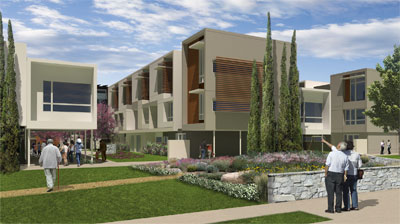In Texas, the Housing Authority of the City of El Paso (HACEP) has begun construction on Paisano Green Community, which will be the first net zero energy public housing development in the nation — a net zero energy building has the capability of generating onsite all of the energy it consumes in one year. In February 2010, HACEP sponsored a nationwide design competition for a green public housing community to replace an older development built in the 1910s. The winning design — by the Boulder, Colorado architecture firm WORKSHOP8 — features several innovative green elements, a mix of unit types, an enclosed garden, and a community center. With 56 one-bedrooms, 9 single-room occupancies, and 8 two-bedrooms, Paisano Green Community will serve very low-income seniors and disabled residents 62 and older who earn 30 percent or less of the area median income.
Sustainable Design

An architectural rendering of the Paisano Green community in El Paso, Texas. Image: Courtesy WORKSHOP8.
Located a few hundred yards from the Mexican border, Paisano Green takes advantage of El Paso's average of 302 sunny days per year with rooftop solar panels that generate the bulk of the power for the residences; two wind turbines provide the remainder. “There’s not even a gas line going into this property,” said Gerald Cichon, chief executive officer of HACEP. “This thing is 100 percent electricity.” In an arrangement known as net metering, Paisano will sell the excess power it generates during the day to the local utility and buy back power at night for an equivalent rate. The development (which is designed to achieve LEED Homes Platinum and Enterprise Green Communities Certification) makes the most of its renewable power sources with passive design strategies that cut overall energy needs in half. The architects limited east- and west-facing windows — those most prone to solar heat gain — and outfitted south-facing doors and windows with overhangs whose depth is calibrated to block direct summer sun but allow passive solar gain when the sun’s path is lower in the sky in winter. A canopy wall along the western edge of the site further deflects harsh afternoon sun in summer and serves as a wind barrier in winter. Utility bills for some of the smaller units are expected to be as low as $8 per year.
Overcoming Barriers
The project is funded by an $8.25 million grant from the American Recovery and Reinvestment Act (ARRA), along with $1.6 million from HACEP and a $500,000 loan from the city of El Paso. As a condition of the ARRA grant, HACEP needed to move quickly; the authority was required to hire a general contractor by September 2010 and spend 60 percent of the funds by the following summer. The city proved instrumental in helping the housing authority meet these deadlines. One major obstacle was zoning; the site’s residential designation did not allow for 92-foot-tall wind turbines, and modifying the code would have delayed the project beyond its deadline. "We had a discussion of, 'Well, we can rewrite our code to allow wind turbines, and we'll have to go research other [city] codes and see what they've done, see how to write it and what's legal in Texas,’" said Marty Howell, sustainability manager for the city of El Paso. Instead, on the advice of the city planners, Howell and HACEP learned about an existing zoning category — general mixed use — that would allow them to effectively set their own height requirements.
City officials were also instrumental in working out a net metering deal with the Public Utility Commission (PUC) of Texas. In July 2010, the utility company announced a new rate structure that ended net metering; the community would have to sell its own excess power at a cheaper rate during off-peak hours (daytime) and buy back power at a much higher rate during peak hours (nighttime). With momentum from a series of public meetings about the issue, the city and HACEP got the utility company to work with them to pass state legislation that created an exception in the rate structure for El Paso, reinstating net metering. “The impact of that for the housing authority has been enormous, and it will save them hundreds of thousands of dollars, maybe even millions of dollars, over the next 20 to 30 years,” said jv DeSousa, architect at WORKSHOP8.
Conclusion
Paisano Green Community replenishes El Paso’s supply of public housing with an ambitious sustainable design. When the project is completed in April 2012 (the grand opening is scheduled for Earth Day), it will be the nation’s first net zero public housing community. By cutting power consumption in half with energy-saving passive design strategies, the development will be able to rely entirely on the solar and wind power it will generate onsite. The availability of net metering made these renewable sources an economically feasible investment, and the savings will extend to Paisano’s residents, who will benefit from substantially lower utility bills.
Next Search Archive
|


